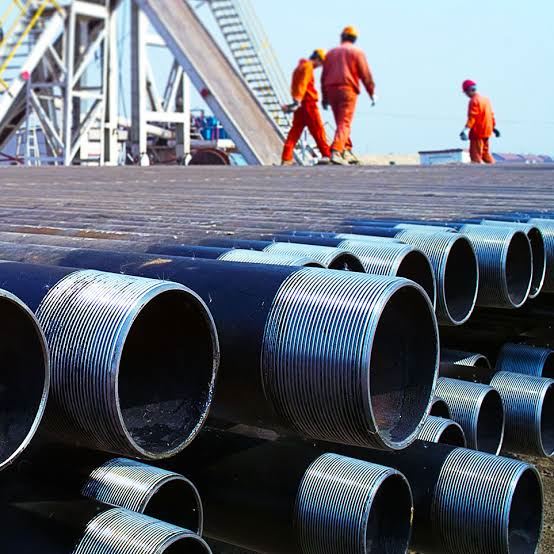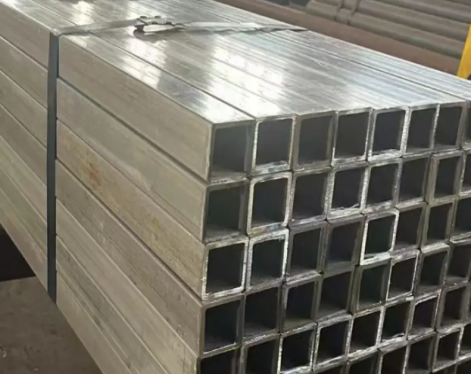What is line pipe?
Line pipe(such as ASTM A106 Line pipe)refers to pipes used to transport fluid media such as oil and natural gas. Its main features are pressure resistance and corrosion resistance. Line pipe can be divided into different grades and specifications according to different uses and pipeline design standards. At present, the commonly used international standards for pipeline pipes include API 5L, ISO 3183, etc., while the domestic standard GB/T 9711 is adopted.
The manufacturing processes of line pipe are generally divided into two types: hot rolling1 and cold drawing2. Among them, hot-rolled line pipe has a smooth surface and is widely used, but its cost is higher; cold-drawn line pipe has a high surface finish, long service life, and lower cost.
What is OCTG pipe?
OCTG pipe refers to pipes used for underground mining of oil, natural gas, etc. Its main features are smooth inner and outer walls, high pressure resistance, and strong corrosion resistance. The slight difference is that the steel characteristics of oil well pipes correspond to those of line pipes. Similarly, oil well pipes also come in a variety of specifications and grades according to different downhole operation requirements and drilling processes. OCTG pipe includes drill pipe, API 5CT casing, oil pipe and other pipe materials. The manufacturing process of oil well pipe includes hot rolling of steel plate, fine burr processing of tube blank, rolling roller, straightening, synthesis, welding, cleaning, dimensional inspection and other links. Among them, oil well pipes are more difficult to manufacture than line pipes, so their production costs are also relatively high.

What is the difference between line pipe and Octg?
In terms of usage, line pipes are mainly used in pipelines for transporting fluid media such as oil and natural gas, while OCTG pipes are used for underground mining. Line pipes focus on penetration and corrosion resistance; oil well pipes focus on load-bearing performance and wear resistance.
From the production process point of view, although both use various manufacturing processes such as hot rolling and cold drawing, the manufacturing of oil well pipes is more difficult, and the difficulty and cost are higher than those of line pipes.
Generally speaking, there are certain differences between line pipes and OCTG pipes in terms of physical properties, uses, and production processes. But they are all indispensable and important materials in the oil and natural gas industry, providing a solid guarantee for the extraction and transportation of oil and natural gas.
Notice:
1. Hot rolling process
Hot rolling is relative to cold rolling. Cold rolling is rolling performed below the recrystallization temperature, while hot rolling is rolling performed above the crystallization temperature. To put it simply, a piece of steel billet is heated and rolled through several passes, then trimmed and straightened into a steel plate. This is called hot rolling. The hot rolling process can significantly reduce energy consumption and reduce costs. Common pipe materials include hot-rolled seamless pipes.
2. Cold drawing process
Cold drawing is a metal processing process also known as cold drawing, cold drawing or cold drawing manufacturing. The process of cold drawing is to stretch the metal material through a mold to reduce the cross-sectional area and improve its physical properties, such as increasing hardness, strength and corrosion resistance. Cold drawn seamless pipes are made by the cold drawing process.
Line pipe(such as ASTM A106 Line pipe)refers to pipes used to transport fluid media such as oil and natural gas. Its main features are pressure resistance and corrosion resistance. Line pipe can be divided into different grades and specifications according to different uses and pipeline design standards. At present, the commonly used international standards for pipeline pipes include API 5L, ISO 3183, etc., while the domestic standard GB/T 9711 is adopted.
The manufacturing processes of line pipe are generally divided into two types: hot rolling1 and cold drawing2. Among them, hot-rolled line pipe has a smooth surface and is widely used, but its cost is higher; cold-drawn line pipe has a high surface finish, long service life, and lower cost.
What is OCTG pipe?
OCTG pipe refers to pipes used for underground mining of oil, natural gas, etc. Its main features are smooth inner and outer walls, high pressure resistance, and strong corrosion resistance. The slight difference is that the steel characteristics of oil well pipes correspond to those of line pipes. Similarly, oil well pipes also come in a variety of specifications and grades according to different downhole operation requirements and drilling processes. OCTG pipe includes drill pipe, API 5CT casing, oil pipe and other pipe materials. The manufacturing process of oil well pipe includes hot rolling of steel plate, fine burr processing of tube blank, rolling roller, straightening, synthesis, welding, cleaning, dimensional inspection and other links. Among them, oil well pipes are more difficult to manufacture than line pipes, so their production costs are also relatively high.

What is the difference between line pipe and Octg?
In terms of usage, line pipes are mainly used in pipelines for transporting fluid media such as oil and natural gas, while OCTG pipes are used for underground mining. Line pipes focus on penetration and corrosion resistance; oil well pipes focus on load-bearing performance and wear resistance.
From the production process point of view, although both use various manufacturing processes such as hot rolling and cold drawing, the manufacturing of oil well pipes is more difficult, and the difficulty and cost are higher than those of line pipes.
Generally speaking, there are certain differences between line pipes and OCTG pipes in terms of physical properties, uses, and production processes. But they are all indispensable and important materials in the oil and natural gas industry, providing a solid guarantee for the extraction and transportation of oil and natural gas.
Notice:
1. Hot rolling process
Hot rolling is relative to cold rolling. Cold rolling is rolling performed below the recrystallization temperature, while hot rolling is rolling performed above the crystallization temperature. To put it simply, a piece of steel billet is heated and rolled through several passes, then trimmed and straightened into a steel plate. This is called hot rolling. The hot rolling process can significantly reduce energy consumption and reduce costs. Common pipe materials include hot-rolled seamless pipes.
2. Cold drawing process
Cold drawing is a metal processing process also known as cold drawing, cold drawing or cold drawing manufacturing. The process of cold drawing is to stretch the metal material through a mold to reduce the cross-sectional area and improve its physical properties, such as increasing hardness, strength and corrosion resistance. Cold drawn seamless pipes are made by the cold drawing process.









